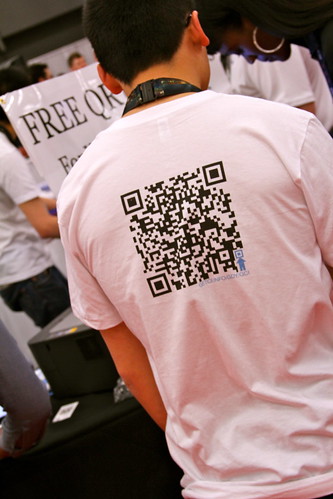In 2010, we started to talk about QR codes … a little.
This year, QR codes are on the rise, popping up at every interactive conference, in magazines and books and anywhere you can print the fancy little squares. You’ll find some interesting statistics on consumer adoption of QR codes in this fascinating presentation by Austin & Williams.
A recent recent report published by ScanLife, estimates that 30-40% of all smart phone users have, at one time, downloaded a bar code scanning application. The report also revealed:
- 61% of all scanned bar codes are from Android operating systems, compared to Apple’s 20% ownership of market share.
- The top five US cities that have adopted QR codes are New York, Houston, Chicago, San Antonio and Las Vegas.
- The largest demographic that has adopted the use of QR Codes are 25-34-year-olds, with 35-44-year- olds close behind.
- 26% of QR code users earn an annual income of less than $50,000, and 35% make between $50,000 — $100,000 per year.
- There was a 1,600% increase in mobile bar code scanning in 2010.
Adoption momentum
From an adoption standpoint, it’s probably going to be some time before QR codes make it out of the hands of Internet geeks and into the mainstream. But the trend is beginning to gain momentum. My gut tells me that widespread adoption will occur faster than we think largely because of the marketing and consolidation of the QR code reader market and deeper integration with smart phone operating systems.
As consumers become more used to technology adoption in general, the habit becomes much less scary for us. Couple that with the rate that new startups are pumping out shiny objects and the widespread success of platforms like Facebook, Groupon as well as Andriod, and suddenly, the barriers are much less intimidating.
Beware the gimmick syndrome

My trip to SXSW this year was a virtual QR code frenzy.
A dense crowd of tech-savvy humans who knew what to do with these fancy little squares descended upon Austin as they do each year. This audience created the perfect environment to experiment with applications of QR code technology.
Some of the applications were very effective. Some were not. Some were simply annoying.
For instance, we saw a ton of shirts displaying QR’s. Good idea, right? Not so much. Notice the slight fold in the individual’s T-shirt? Good luck getting an application like QuickMark to actually process that image and bring up the link.
Then there were the cupcakes. While tasty, this was a completely failed use of the technology in my opinion.
If you think the shirt was difficult to scan, you should have tried these little snack items.
But don’t worry. My frustration was quickly calmed by the yummy icing. I never made it to the landing page as the company would have liked me to. In fact, I couldn’t even tell you one thing about the company. Can you see the problem with this gimmicky approach?
Doing it right
44Doors is doing QR codes right in all directions. While this is a paid platform, they are light years beyond the free QR Code generators you can find online.
One of the case studies that caught my attention immediately centers on 44Doors’ work with Kendall Jackson Wines.
By placing a QR code on the label or as a tag around the neck of the bottle, Kendall Jackson can offer its customers all kinds of different information at the point of purchase. It’s relevant, timely and unique, which can influence the ultimate purchase decision.
6 things to know about using QR codes in content marketing
When you are thinking about using a QR code as part of your interactive strategy, make sure you consider these important points:
1) Know where your audience is and what they need when they encounter your QR code.
Many users are not tech savvy and do not know what a QR code is. Provide some instructions to educate them on what QR codes are, what they do, and how to use them.
2) Suggest a QR code reader for your audience to use.
For less savvy audiences, you may want to suggest one or more QR code readers they could download. Make sure to recommend what you know works, and make sure readers are compatible with both Andriod and iPhone OS. Here are some readers I recommend:
3) Use an appropriate call to action.
Where do you want to take your audience so that they can take the next step? Once they land, what will you ask them to do?
4) Create the right landing page.
Once the QR code is scanned, make sure the information you deliver is relevant to where the end user is at that place and time. Location is a critical factor.
5) Display QR codes on a flat surface.
If you’re QR code is wrinkled or folded, your audience will have trouble scanning it, get frustrated and move on.
6) Always keep it simple.
Essentially, a QR code is a conversion point in real life. Don’t get too fancy or clutter up the code with noisy and distracting images and graphics.
There’s plenty more to consider. What else would you add? How would you use a QR code in your marketing?


